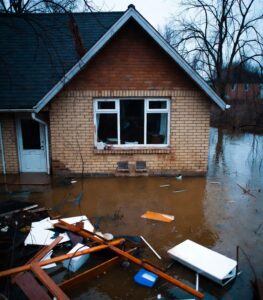Does Renters Insurance Cover Flood Damage
Wondering whether renters insurance covers flood damage? You’re not alone. Many renters assume their standard policy will step in if rising water damages their belongings—but in most cases, it won’t.
Flooding is typically excluded from basic renters insurance, meaning you may need a separate policy to stay fully protected.
Understanding what your coverage includes—and what it doesn’t—is essential before disaster strikes.
In our previous article where we explained that Renters insurance is one of the most affordable ways to protect your personal belongings and provide peace of mind while renting a home or apartment.
Many renters are surprised to learn just how inexpensive this coverage can be. On average, renters insurance costs between $15 and $30 per month in the United States, depending on factors like location, coverage limits, and the type of policy you choose.
Despite its low cost, renters insurance offers valuable protection against losses from theft, fire, or other unexpected events.
Understanding how much is renters insurance costs per month—and what affects those costs—can help you find the best policy for your needs and budget.
Does Renters Insurance Cover Flood Damage?
Flooding is one of the most common—and costly—types of natural disasters in the United States, yet many renters are surprised to learn that their standard renters insurance policy does not typically cover damage caused by floods.
While renters insurance is designed to protect your personal belongings from events like fire, theft, and certain types of water damage, it draws a clear line when it comes to natural flooding.
Understanding what your policy does and doesn’t cover is essential, especially if you live in an area prone to heavy rain, hurricanes, or overflowing waterways.
Without the right coverage in place, a single flood event could destroy thousands of dollars’ worth of personal property—with no financial protection.
Types Of Water Damage Renters Insurance Cover And Don’t?
Renters insurance (HO-4 policy) typically covers water damage, but only from certain sudden and accidental sources. Here’s a clear breakdown of the main types of water damage that are usually covered by standard renters insurance (personal property coverage):
Water Damage Types Typically Covered
Burst pipes
- A pipe suddenly freezes and bursts or ruptures due to pressure → Covered.
Plumbing leaks that are sudden and accidental
- Example: A supply line to your washing machine or toilet suddenly cracks and floods your apartment → Covered.
Overflow from appliances
- Your dishwasher, washing machine, or sink overflows due to a malfunction → Usually covered.
Water damage from putting out a fire
- Firefighters break a pipe or use hoses, and water damages your belongings → Covered.
Leaking or bursting water heater
- Sudden failure that floods your unit → Covered.
Roof leak caused by a covered peril
- A tree falls on the roof during a storm (windstorm is covered), causing rain to come in → Covered.
Note: The landlord’s building insurance covers the roof repair, but your renters policy covers your soaked couch, clothes, electronics, etc.
Ice dam leaks (in some policies)
- Melting snow backs up under shingles and leaks in → Sometimes covered, but many insurers now exclude or limit or exclude this — check your policy.
- Accidental discharge or overflow from plumbing, heating, A/C, or household appliances
- This is the key named peril in most policies — if the discharge is sudden and accidental, your stuff is covered.
Water Damage Types Almost Always Excluded (Not Covered)
Gradual leaks (e.g., a slow toilet leak over months)
- Flooding from outside (rain, rivers, hurricanes, storm surge) → Needs separate flood insurance
- Sewer backup or sump pump failure → Usually excluded unless you add the endorsement (costs ~$40–$100/year)
Mold remediation (often limited or excluded)
- Damage from neglect or lack of maintenance
- Earthquakes or landslides causing water damage
Quick Rule of Thumb
- If the water damage is sudden and accidental from inside the plumbing system or a covered peril → Usually covered for your belongings.
- If it’s gradual, external flooding, or sewer backup → Not covered without add-ons.
- Always read your policy declarations page or call your insurer — some companies (State Farm, Allstate, Lemonade, etc.) have slightly different wording or optional water backup coverage limits ($5k–$250k).
How To Get Flood Coverage As A Renter?
1. Purchase a Flood Insurance Policy Through the National Flood Insurance Program (NFIP)
- The NFIP, managed by FEMA, is the most common source of flood insurance in the U.S. Renters can purchase contents-only flood insurance, which covers your personal belongings—not the building structure (that’s your landlord’s responsibility).
What NFIP policies offer renters:
- Coverage for clothing, electronics, furniture, and other personal property
- Up to $100,000 of personal property coverage
- A 30-day waiting period before coverage takes effect (except in some special cases)
How to buy it:
1. Visit an NFIP-participating insurance agent.
2. Get a quote based on your flood zone and how much coverage you want.
3. Complete the application and pay the premium.
2. Consider Private Flood Insurance
- Private insurers offer flood coverage outside of FEMA’s NFIP. These policies may include:
- Higher personal property limits than NFIP
- Shorter (or no) waiting periods
- Additional coverage options, such as temporary living expenses after a flood (which NFIP does not cover)
Private flood insurance can be a good option if:
- You want more coverage than NFIP’s $100,000 limit
- You want faster effective dates
- Your home is not in a high-risk flood zone and you’re looking for cheaper premiums.
3. Check if Your Property Management Company Offers Optional Flood Coverage
- Some large apartment complexes partner with insurance providers to offer add-on flood coverage for renters. These policies typically:
- Are cheaper than standalone flood insurance
- Can be added to your renters insurance premium
- Cover personal belongings damaged by flooding
- Always read the fine print—coverage can vary widely.
4. Understand What Flood Insurance Covers
Whether you buy NFIP or private flood insurance, renters policies generally cover:
- Personal property damaged by rising water
- Belongings in storage units (up to certain limits)
- Cleanup and debris removal in some policies
They do not typically cover:
- Damage to the building structure
- Temporary housing (unless you have private coverage with that option)
- Cash, precious metals, and some high-value items unless scheduled separately
5. Determine How Much Coverage You Need
To choose the right policy:
1. Add up the value of your personal belongings
2. Consider replacing furniture, electronics, clothing, and kitchenware
3. Factor in specialty items (instruments, collectibles, jewelry)
If your belongings are worth more than NFIP’s limit of $100,000, private insurance may be better.
6. Get Multiple Quotes Before Buying
Prices can vary depending on:
- Your flood zone
- Your building’s elevation
- Your insurer
- The deductible you select
It’s smart to compare at least two or three quotes from NFIP-participating agents and private insurers.
7. Don’t Wait Until a Storm Is Forecast
- Flood insurance usually has a 30-day waiting period, meaning you won’t be covered if a storm is already on the radar. The best time to buy is before flood season.
What To Do After Flood Damage Occurs?
Here’s a clear, practical step-by-step guide for what to do immediately after flood damage occurs. Act quickly—the first 24–48 hours are critical to minimize damage, protect your health, and preserve your insurance claim.
Immediate Safety First (First 1–4 Hours)
Stay out until authorities say it’s safe
- Don’t enter the building if there’s standing water and power is still on, or if the structure looks unstable.
Turn off electricity and gas (only if safe)
- If you can reach the main breaker/box without stepping in water → turn off power.
Shut off the main gas valve if you smell gas or hear hissing.
- Document the damage for insurance (start now)
- Take photos and videos of everything: water levels, damaged items, mud, structural issues.
- Don’t throw anything away yet (furniture, appliances, carpet, etc.) until the adjuster sees or photographs it.
Contact your insurance company ASAP
- Report the claim immediately (most policies require “prompt notice”).
- Ask if you have flood insurance (standard homeowners policies almost never cover floods—separate NFIP or private flood policy is required).
First 24–48 Hours – Reduce Further Damage (“Mitigation”)
Insurance expects you to take reasonable steps to prevent worse damage.
Remove standing water
- Rent or buy a wet/dry shop-vac or pump.
- If water is more than ~2 inches deep, hire a water-removal company (many insurance policies cover this).
Start drying out the property
- Open windows and doors for ventilation (if outside humidity is lower).
- Rent industrial fans and dehumidifiers (hardware stores, equipment rental places).
- Remove wet carpet, padding, and drywall (at least 12–18 inches above the water line, or “flood cut”).
Prevent mold
- Anything porous that stayed wet >24–48 hours (drywall, insulation, carpet, upholstery) usually has to go.
- Use EPA-registered antimicrobial sprays on studs and hard surfaces.
Protect valuables
- Move undamaged items to a dry area.
- Freeze important wet papers/photos/documents in plastic bags until you can deal with them (prevents further damage).
Next 3–14 Days
- Meet the insurance adjuster
- Walk through with them and point out all damage.
- Provide your photo/video documentation and an inventory list of damaged items (description, age, approximate value).
Get at least 3 contractor estimates
- Choose licensed, insured contractors experienced with flood repair.
- Beware of “storm chasers” and contractors who demand large upfront payments.
Keep receipts
- Every expense you pay out-of-pocket for emergency pumping, fans, hotel stays, etc. may be reimbursable.
Apply for government assistance if needed
- FEMA Individual Assistance (disasterassistance.gov)
- SBA low-interest disaster loans (sba.gov/disaster) – available even to renters.
Common Mistakes to Avoid
- Don’t turn power back on until an electrician inspects.
- Don’t keep wet drywall or insulation longer than necessary—mold grows fast.
- Don’t sign any contractor’s “Assignment of Benefits” (AOB) without understanding it—can complicate your claim.
- Don’t throw away damaged items until the adjuster documents them (take photos first if you must discard for health reasons).
How Much Does Flood Insurance Cost?
Flood insurance costs vary widely based on your location, home details, and coverage level, but the national average for a policy through the National Flood Insurance Program (NFIP)—the federal program administered by FEMA—is around $800–$900 per year (or $67–$75 per month), based on 2025 data.
This is an increase from pre-2023 averages due to FEMA’s Risk Rating 2.0, which prices policies more accurately based on individual risk factors.
Private insurers may offer similar or slightly higher/lower rates, often with more flexible coverage options.
Conclusion

Floods can happen quickly and unexpectedly, and the damage they cause can be costly. While standard renters insurance offers valuable protection against many types of losses, it does not cover flood damage caused by natural events.
Understanding this gap is essential for renters who want to fully protect their belongings.
Fortunately, affordable options like NFIP flood insurance and private flood policies give renters a way to secure the coverage they need.
By knowing your local flood risk, reviewing your insurance limits, and exploring dedicated flood insurance, you can ensure that unexpected rising water doesn’t lead to unexpected financial hardship.
Taking a proactive approach today can save you thousands tomorrow — and give you real peace of mind, no matter where you live.


